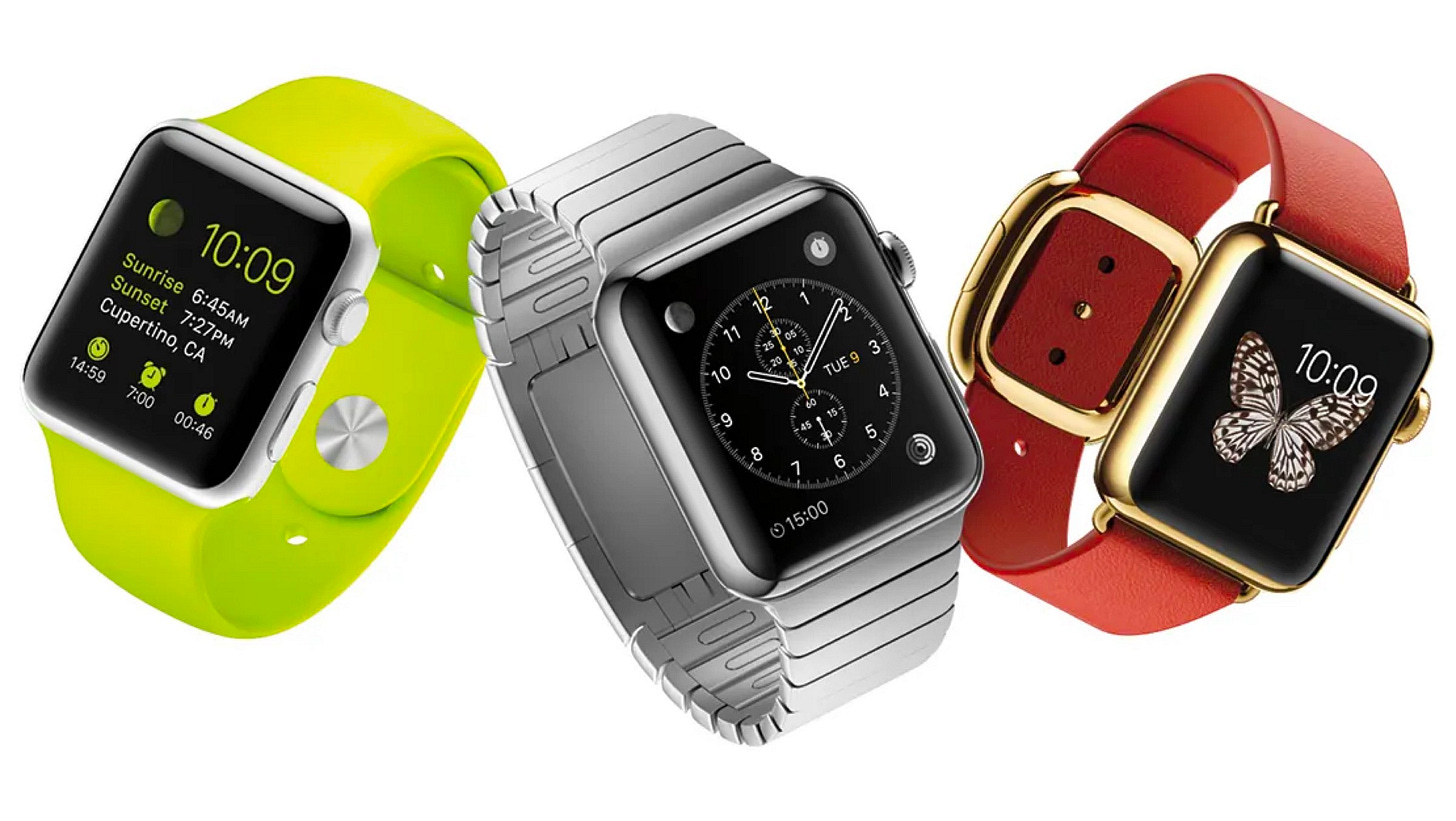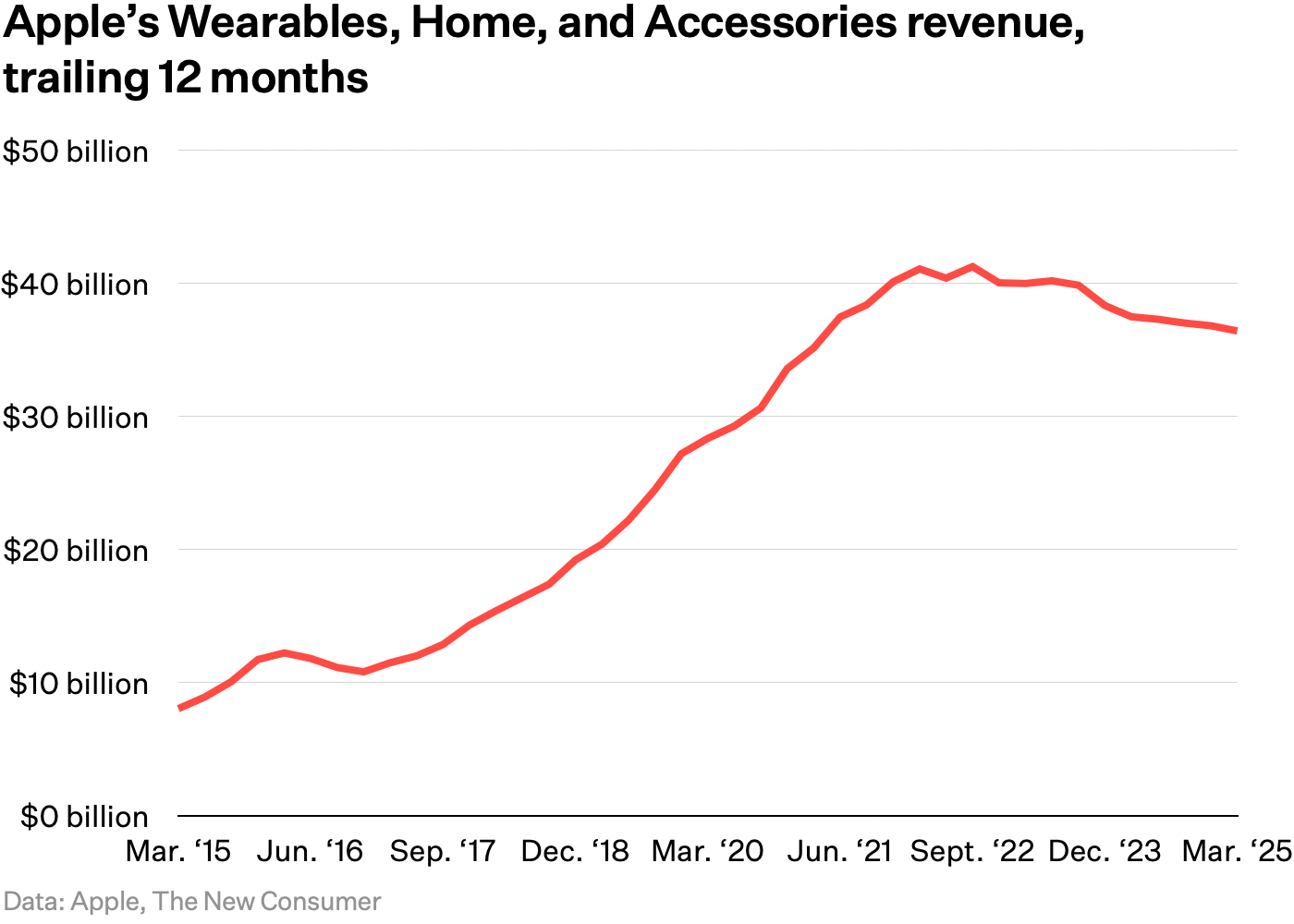A decade with the Apple Watch
Thoughts, observations, and exclusive new data, after 3,675 days on the wrist.
Hello hello! It’s Dan Frommer, back with The New Consumer.
One quick note: I’m excited to be speaking at the WSJ Global Food Forum next month in Chicago, alongside Siete Foods co-founder Miguel Garza, Shake Shack CEO Rob Lynch, and Jeni Britton, founder of Jeni’s and now Floura. It’s coming up soon — June 16 and 17 — so please request an invitation today (and use my code NEWCONSUMER20 at checkout to save 20% on your pass). I hope to see you there!
Also, I’m planning to interview Oats Overnight CEO Brian Tate soon about building subscription-focused direct-to-consumer businesses — theirs is now more than 90% subscription. I’d love to include your questions for Brian, prioritizing members — please reply to this email or write me at dan@newconsumer.com.
Presented by The WSJ Global Food Forum
Join The Wall Street Journal’s Global Food Forum, June 16–17, 2025, at the Four Seasons Hotel Chicago.
This premier event gathers top executives, investors, policymakers, and innovators across the food and agriculture sectors for a full day of candid interviews and timely conversations.
Explore key topics including dining trends, climate innovation, farm policy, inflation, and investment in breakthrough technologies and products. Connect with influential leaders shaping the future of food — and leave with the insights you need to stay ahead.
As a subscriber of The New Consumer, use code NEWCONSUMER20 at checkout to save 20% off your pass.
There are very few things, other than basic biological functions and coffee, that I’ve done every day for the past 3,675 days. One of them is wearing an Apple Watch, which first went on sale in late April 2015, and recently celebrated its tenth birthday.
The Apple Watch is a fascinating product. It is one of the most successful consumer products in history — a true mainstream hit that’s generated more than $100 billion in revenue in a decade.
Around one in three iPhone owners in the US also claims to own an Apple Watch, according to my recent Consumer Trends research. Its popularity skews younger and wealthier, but is evenly distributed among Trump and Harris voters.
Yet because it’s only perhaps Apple’s fifth or sixth most important innovation this century (iPhone, iPod, Apple Silicon, App Store, MacBook Air, Watch, AirPods?), it’s often overlooked or at least overshadowed. A few of these products legitimately changed the world. The Watch — while an important part of Apple’s ecosystem — has not.
The Watch is Apple’s most aesthetically customizable product, and yet its most conspicuous. A plump metal knob on your wrist, often attached by an oddly colored rubber or velcro strap, there is no mistaking an Apple Watch for something else.
You immediately notice them everywhere, in part because they stick out — a glimpse into the look a person is trying to cultivate; a tiny badge of modern earnestness. My last flight across the country, every flight attendant I saw was wearing one; my last doctor’s visit, every nurse.
But they’re great tools!
I use mine to: Pay almost everywhere, track my runs and steps, never miss a phone call, wake up silently for early flights, monitor coyote traffic on the driveway cam, time six-minute eggs, read email newsletters, see the AQI, find my phone, ride the Shinkansen, take an EKG, rewind the podcast, use as a flashlight to navigate a dark room, and intercom to the HomePods. Oh — it also turns out that it’s very convenient to know the time without always having to fish out a phone.
They look dorky in photos, but are regrettably worth it. My titanium Ultra is the wristtop computer that my high school self would have gone nuts for.
Rather than status, the Apple Watch’s popularity is really because of its utility, which is the purest form of success.
In our research, Apple Watch users use it, in part to live a better, healthier, more active life.
More than half (57%) of Apple Watch users said they’ve tracked their steps over the past year, compared to 34% of Americans overall, according to our latest Consumer Trends Survey of more than 3,000 US consumers, conducted in late February by Toluna. (This poll was part of my Consumer Trends research series, produced in collaboration with Coefficient Capital; this is the first time we’ve published these stats.)
These also tend to be conscientious types, more broadly: More than one third (38%) of Apple Watch users say they’ve tracked their eating habits for at least one week over the past year, compared to 22% of our overall panel. Some 35% of Apple Watch users say they’ve made changes to their diet based on data, compared to 25% of the broader population.
Is this actually making a difference? Could the Apple Watch prolong your life? That will require further study. But Apple Watch users think they’re healthier: Almost half (47%) said they would rate their current health “excellent” or “very good,” compared to 36% of our overall panel.
Using an Apple Watch even correlates to greater happiness: When we asked our survey panel of 3,294 people to rate, on a scale of zero to ten, their overall satisfaction with life as a whole these days, the average response in late February was 6.69. Among people who said they’d used an Apple Watch over the past week, it was 7.35.
Obviously, this is almost entirely a reflection of their broader demographics — a lot of employed, upper-income Millennial parents in cities and suburbs — rather than any specific joy tied to the Apple Watch. Still worth noting!
Of course, for me, a decade of wearing the Apple Watch has meant a decade of writing about it. I was pretty optimistic from my early experiences onward.
There was a lot of noise and high expectations around wearable tech back then. In its first decade, I’d say the Apple Watch has proven both that there is a mass market for these things and that they, so far, aren’t revolutionary devices. The Watch makes the iPhone better, and therefore strengthens Apple’s ecosystem (and platform lock-in). But its magic feels limited.
One thing is that like many — including, perhaps, Apple — I overestimated the role that apps would play on the Watch.
“If you’re smart and lucky, the Apple Watch could make you a billionaire,” I wrote to mobile developers in 2015. “All you need to do is figure out the WhatsApp, Uber, or Snapchat for the wrist-computer era, and build it.”
That is… not how things turned out. There are no Watch-native messaging platforms, network effects, nor unicorns. The iPhone (and cloud) is still where innovation is most potent. Most of the best Watch tools are built into the operating system (notifications, Apple Pay, “Live Activity” trackers, watch face widgets) or are simple extensions of iPhone apps (buttons, remote controls).
Still, thinking ahead to the next decade, while I hope that I’ll have also finally found a “real” watch that brings me joy, I acknowledge that it would be tough to go out for long without the Apple Watch.
Sales, however, have plateaued. Apple doesn’t break out quarterly Watch sales or revenue, but its category — Wearables, Home, and Accessories; mostly the Watch and AirPods — peaked a few years ago.
CHART OF THE DAY
Apple is still selling plenty of Watches — about 40 million per year, analyst Neil Cybart estimates. But growth is not accelerating, and its user base — more than 200 million globally, Cybart estimates — is growing more slowly than it used to.
Part of the “problem” — the scariest of scare quotes, here — is that Apple Watches last a very long time, and there isn’t a frequent need to upgrade. (Competition isn’t really the story: There are some more specialized, niche devices like the Whoop band and Oura ring out there, and market-specific smartwatch alternatives, especially in China. But you’re generally either an Apple Watch person or not.) I’m on my ~fifth in a decade, but I’m also the kind of person who greatly enjoys new gadgets.
Meanwhile, the Watch software isn’t demanding enough to require faster chips; new sensors and health features, such as blood sugar and blood pressure monitoring, are taking a long time to develop; Apple hasn’t made any breakthroughs in device thinness that would necessitate an aesthetic upgrade. Everything is working fine, but the platform has not evolved rapidly.
Looking forward, it seems easy, now, to pinpoint the Watch’s biggest weakness, which is one of Apple’s biggest weaknesses: Siri, its all-encompassing AI assistant.
The Watch’s small screen and wrist position has meant — and will mean — that it’s never going to be the best device for visual user interfaces, where anything much more complicated than a button or two would be appropriate.
For a while, reviewers would critique the Watch on how close it was getting to potentially replacing your iPhone. I’m not sure that’s something people really want — the iPhone is the best computer in the world, and it’s almost never a nuisance to carry.
But in theory, you should be able to conduct far more sophisticated operations on something like the Watch (or even AirPods) by having a conversation with a state-of-the-art AI assistant. Siri is, unfortunately, nowhere close to state-of-the-art, and can barely handle simple commands and look-ups. Bummer.
Apple knows that this has to change — that AI is simply too important a piece of its future to continue sucking. So, I hope, through first- and third-party tools and services, this part of the Watch will improve. Though, like apps a decade ago, I may be overestimating its actual transformative effect for this one device. We’ll see in another decade.
Data sheet
Almost one in five US consumers — 17% — say they’ve used an Apple Watch in the past week, according to our most recent Consumer Trends Survey of more than 3,000 Americans ages 15 and up, conducted in late February by Toluna. This poll was part of our Consumer Trends research series, produced by The New Consumer in collaboration with Coefficient Capital.
Apple Watch active usage is highest among Millennials (25%) and Gen. Z (24%) while lower among Gen. X (15%) and Boomers+ (10%).
Men and women report using an Apple Watch in nearly identical proportions. Trump and Harris voters, too.
It has become a very successful iPhone accessory: Almost one third of people (31%) who say they’ve used an iPhone in the past week say they’ve used an Apple Watch during that period. A similar portion, 32%, say they’ve used AirPods.
Apple Watch usage increases with income: Just 11% of those earning under $50k in household income report using an Apple Watch over the past week, compared to 18% of those earning $50k to $100k, and 31% of those earning more than $100k. People with full-time jobs overindex as Apple Watch users, as do people with one or more children living in their household.
In our survey, Apple Watch users overindex in many health and wellness-focused areas.
More than half — 57% — of Apple Watch users said they’ve tracked their steps over the past year, compared to 34% of our overall survey panel. Half (49%) of Apple Watch users said they tried to walk a certain number of steps per day, compared to 40% of our overall panel.
More than one third — 38% — of Apple Watch users say they’ve tracked their meals and/or calories for at least one week over the past year, compared to 22% of our overall panel. Some 35% of Apple Watch users say they’ve made changes to their diet based on data, compared to 25% of our overall panel.
Apple Watch users were also much more likely to say they were consumers of health-related media — watching health-related videos, following health- or wellness-focused social media accounts, listening to health-related podcasts, and making changes to their diet based on a video or podcast. They were also more likely to have worn a continuous glucose monitor (CGM) to track blood sugar (12%) compared to our overall panel (7%).
Apple Watch users were also more likely to say they considered themselves “extremely” or “very” informed when it comes to living a healthy life, and when it comes to new developments, research, and advice in health and wellness.
Roughly the same proportion of Apple Watch users (51%) said they took supplements on a daily basis over the past year as our overall survey panel (50%).
Apple Watch users were more likely to say they shopped at every grocery store in our survey, but especially Instacart, Whole Foods, Costco, Trader Joe’s, and Target, as well as local health food stores and farmer’s markets. This is probably more of a reflection of their broader demographics than anything specific to the Apple Watch.
Apple Watch users think they’re healthier: Almost half (47%) said they would rate their current health “excellent” or “very good,” compared to 36% of our overall panel. Fewer also rated their health “fair” or “poor.”
Apple Watch users also think they’re happier: When asked to rate, on a scale of zero to ten, their overall satisfaction with life as a whole these days, the average US response in late February was 6.69. Among people who said they’d used an Apple Watch over the past week, it was 7.35.
Presented by The WSJ Global Food Forum
Join The Wall Street Journal’s Global Food Forum, June 16–17, 2025, at the Four Seasons Hotel Chicago.
You’ll hear from farmers and food makers about how they’re navigating crisis like new tariffs, bird flu, and inflation.
Chefs, investors, and policymakers will share how they’re pushing boundaries with generative AI and other innovations. And you’ll take away strategies to be a part of the next generation of the food industry.
As a subscriber of The New Consumer, use code NEWCONSUMER20 at checkout to save 20% off your pass.





